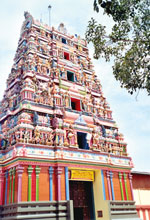‘Indo-European’ religion encapsulates many tribal traditions

Hindu temples have no formal services. However some temples carry out certain rites daily or weekly.
Hinduism is one of the oldest religions in the world. Hinduism began around 1500 B.C., around the time of the Aryan Migration.
During the migration, the peoples who had formerly inhabited the fertile lands between the Caspian and Aral Seas left the land and spread out to the east, west and south. The Aryans are often referred to as “Indo-European,” for those who migrated west are the ancestors of many Europeans, and those who migrated south are the ancestors of many Indians. The religious traditions they brought with them laid the foundations for Hinduism.
In the beginning (at least the beginning of recorded south-Asian history), the Aryan religion of the Vedas was directed by Brahmin priests.
Brahmins are the uppermost level in a system of social stratification outlined by the Vedas; this system is now known as the caste system.
Brahmins occupy the top level, followed by Kshatriyas (nobles and warriors), Vaishyas (merchants and business people) and Sudras (servants and peasants). There is even a caste so low it is not considered a caste at all – the Dalits, or “untouchables.”
Though officially unconstitutional, the caste system still plays a big role in Indian society, and its complete abolition is the focus of a major political movement led by Dalits.
Hinduism is not a single faith but a collection of similar practices and histories. The Hinduism one sees in India today invokes deities such as Hanuman (the monkey god), Lakshmi (goddess of prosperity) and Ganesh (symbol of good luck and the remover of obstacles). These deities give meaning to everyday life and provide a focus for faith and devotion. Although there are many different deities, some specific to only a few villages, the divine trinity of Brahman, Vishnu and Siva, also known as the Trimurthi, is universal. These three deities represent creation, preservation and destruction, respectively, and have played an important role, both historically and in the contemporary religious lives of Indians.
Hinduism today can best be understood from two vantage points: stories and practice.
The stories of Hinduism are recorded in the epic poems, the “Ramayana” and the “Mahabarata.” Though many Hindus may not have read either, the stories of these epics are everywhere in India – in films, children’s stories and in public murals in every Indian city. In the late 1980s, Doordarshan, India’s national television station, ran a serial version of the “Ramayana.” The show was hugely popular; India virtually stopped every Sunday morning as people were glued to their televisions. Murals in temples show the story of Rama, “Ramayana” means, roughly, “Rama’s way,” and there are children’s comic books telling the stories of Rama, Hanuman, Krishna and a collection of Indian mythological figures.
The practice of Hinduism is different from congregational-based religions like Christianity. Daily puja, or worship, begins at the shrines in every Hindu home. These shrines may be no larger than the kitchen corner, for a poor family, or may occupy an entire room in the home of upper-class Indians. The basic elements of a shrine include an image or symbol of a Hindu god or goddess – most often Siva or Vishnu – some incense and a place (such as a plate or bowl) to offer food or flower petals to the deity. Pictures of Jesus, Muhammad, the Buddha or anyone else who has been important in the person’s life may also be found at a shrine. Indian shops are stocked with statues, incense and other ingredients for home shrines.
Even public worship is highly individual. There are no services at Hindu temples: mostly worshippers come and go on their own, carrying out their daily duties. However, in many temples certain rites are carried out on a daily or weekly basis.
Dr. Ree Wells and I were able to see in one ceremony at a temple in Kerala a procession of devotees who circled the inner chamber of the temple beating drums and chanting; they then entered the inner-chamber and left an offering to the mother-goddess shrine inside. As in the home, each public shrine is devoted to an individual god or goddess. At the shrine, people offer food, pray or chant and generally leave a donation for the temple.
Hinduism places many constraints on its believers. High-caste Hindus are prohibited from consuming meat and may only eat food prepared by a member of their own caste (or higher). Marriage is almost always within one’s own caste.
Hindus do not believe in an afterlife on the Christian model, though they believe in reincarnation, an infinite cycle of death and rebirth. A moral life will result in a person’s rebirth to a higher level of consciousness.
The ultimate goal is not heaven, but enlightenment through knowledge.
The overwhelming characteristic of Hinduism is its diversity and evolution.
During the last 3,000 years, the religion has developed rich philosophies, intoxicating tales, a plethora of gods, and, recently, a virulent nationalism that threatens the future of the world’s largest democracy.
Your donation will support the student journalists of Missouri Southern State University. Your contribution will allow us to purchase equipment and cover our annual website hosting costs.



























